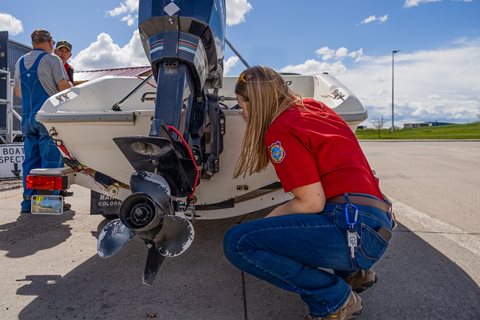Watercraft Inspection Stations Are Open, Looking For AIS
Watercraft inspection stations across the state of Wyoming have opened for the boating season and are on the lookout for aquatic invasive species (AIS). By the end of May, five watercraft containing invasive mussels were intercepted coming into the state by the Wyoming Game and Fish Department. Two of those watercraft traveled through the Interstate-90 Beulah check station.
“Intercepting watercraft containing mussels this early in the season is concerning, but it’s not surprising,” said Josh Leonard, Game and Fish AIS coordinator. “It just goes to show the increased threat of AIS we’re facing on our eastern border.”
In an attempt to mitigate the risk of mussels entering Wyoming, two new AIS inspection stations have opened along the eastern border — one in Newcastle and the other in Manville. Inspectors have already conducted more than 300 combined inspections at these locations. Of these inspections, 19% in Newcastle and 31% in Manville have been high risk.
“Boaters are recognizing that watercraft inspections are key to keeping zebra and quagga mussels and other AIS from spreading — and that keeping mussels out is what’s best for the resource,” Leonard said. “Inspections usually don’t take long, but stations can get busy — especially around a holiday weekend. You can speed up your inspection by making sure there’s no mud, plants or standing water in your boat.”
Other threats
Wyoming is one of six states in the continental United States without known populations of invasive mussels. While mussels are a main focus of the Game and Fish AIS program, they are not the only AIS concern in the state. Curly pondweed, brook stickleback, Asian clams, New Zealand mudsnails and rusty crayfish have all been found in the Cowboy State. Last year a previously undiscovered population of Asian clams was found in Glendo Reservoir.
The combination of AIS coming in from out of state and being spread between different waters in-state means that all boaters should follow the Clean, Drain, Dry protocols. It is recommended boaters traveling between waters but staying in Wyoming should allow their watercraft to dry for five days during the summer and remove all bilge and drain plugs at the boat ramp
Regulations changes
It’s state law that all boaters must stop when coming upon an AIS inspection station — even if they stopped at one prior or do not intend to launch in Wyoming. This applies to anyone with a watercraft, which includes but is not limited to kayaks, canoes, rafts and paddleboards. Any watercraft transported into Wyoming from March 1–Nov. 30 must undergo a mandatory inspection by an authorized inspector prior to launching on any Wyoming waterway. If boaters entering Wyoming do not encounter an open AIS check station on their route of travel, it is the boater’s responsibility to seek out an inspection. If the watercraft was used on a water suspect or positive for invasive mussels in the last 30 days, it must be inspected prior to launching year-round and may require decontamination. Full rules are available online.
Watercraft owners should be aware of a statutory change that went into effect Jan. 1. Wyoming Statute 23-4-203 states if a watercraft owner entering Wyoming from out of state fails to have their watercraft inspected prior to launching, the boater has 48 hours after being stopped by a qualified peace officer to obtain an inspection from a certified inspector. The boater may not launch in Wyoming water until the inspection is completed. Failing to obtain an inspection within the 48-hour window is a misdemeanor, punishable by a fine of up to $5,000 and the boater may be prohibited from operating any watercraft in Wyoming for up to three years.
It is important know that requirements for inspections and decals are different. You can learn more about AIS decal requirements on the Game and Fish website.

